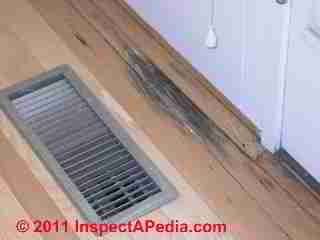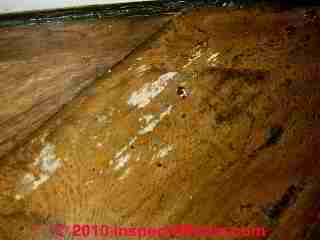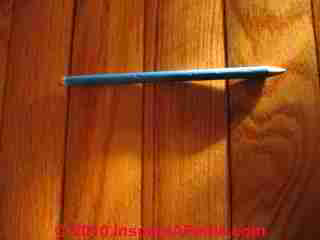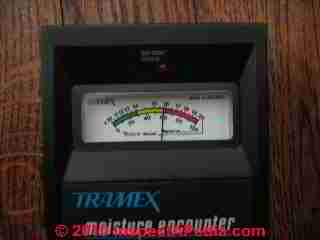 How to Clean Mold on Wood Flooring
How to Clean Mold on Wood Flooring
- POST a QUESTION or COMMENT about mold contamination on building floors and in floor coverings or floor materials
This article offers advice on cleaning mold found on wood flooring, both when the flooring is already installed in a building and when wood flooring materials have not yet been installed in place.
We discuss the pros and cons of using fungicidal sealants and bleach on wood floor product surfaces including the under-side as a mold-resistance improver, and give sources and list types of those products.
We also discuss common errors made when cleaning wood surfaces, such as relying on bleach or performing expensive and unnecessary cleaning on cosmetic black mold on wood surfaces.
InspectAPedia tolerates no conflicts of interest. We have no relationship with advertisers, products, or services discussed at this website.
- Daniel Friedman, Publisher/Editor/Author - See WHO ARE WE?
Guide to Cleaning Mold off of Wood Flooring
 at left our photo shows white and black mold on the surface of hardwood flooring. It may be possible to sand, clean, and re-finish this floor, but some exploration will be needed:
at left our photo shows white and black mold on the surface of hardwood flooring. It may be possible to sand, clean, and re-finish this floor, but some exploration will be needed:
- What caused this mold growth on flooring, and has the leak or moisture problem been corrected?
- Is there a risk of hidden mold between layers of flooring and if so, will that be a health or mold growth risk in the building?
- Does the mold growth on this floor indicate that the flooring is rotted and needs replacement, or can the mold be cleaned off and the floor remain in use?
Our page top photo shows black mold on an oak strip floor near an exit door. Sanding or bleaching this mold won't fix anything - we need to find and fix the leak that caused this flooring to rot, and because the flooring is rotted, it needs to be replaced.
But often surface mold on wood flooring, new or installed in a building, can be easily cleaned and future mold growth prevented, as we describe here.
Question: How do I clean mold off of oak flooring that has not yet been installed?
I have recently found some used quarter sawn oak 3/4" tongue and groove flooring for sale. Upon further inspection, many of the pieces appear to have a white powder film on the finished side of the strips and also black mold on the back sides where is it grooved and unfinished.
Of course it is being sold at an incredible price, but I am concerned about the likeliness I will not be able to clean it properly. I will add that I will be gluing it down to concrete.
Is there anything I can do myself to insure proper elimination of the mold? - Jamie Longfellow, Tallahassee, FL
Answer: Physically Clean Moldy Wood Surfaces, Dry The Wood Flooring Before Installation
Here we are discussing cleaning mold off of wood flooring products that have not yet been installed in a building. If your concern is with mold on the visible surfaces of wood flooring already installed in a building, or on the under-side of wood flooring or subflooring already installed in a building, the wood surface cleaning discussed here still applies, but you should also see HIDDEN MOLD in FLOOR / SUB-FLOOR. Also see MOLD CLEANUP - WOOD FRAMING & PLYWOOD where we describe methods for cleaning wood surfaces in general.
Without a mold lab test (for example using the adhesive tape mold sample procedure at TEST KIT for DUST, MOLD, PARTICLES: INSTRUCTIONS) we don't know from the moldy flooring question above if you are seeing mold or something else on soiled wood flooring, but it is reasonable to guess that a substance is mold based on its physical appearance (see MOLD APPEARANCE - WHAT MOLD LOOKS LIKE), especially if the flooring has been exposed to water, wet conditions, or high humidity.
Except where major costs are at issue that would be effected by a determination of the type of material or mold present, or where there are other reasons to test for mold, in our opinion testing is not necessary for small mold cleanup jobs (less than 30 sq.ft. of contiguous mold on a building surface). For help in deciding if it is appropriate to test for mold, see Reasons to Test for or Identify Mold and see MOLD / ENVIRONMENTAL EXPERT, HIRE ?.
In any case you can physically clean the surfaces to remove the mold. Physically cleaning means wiping, scrubbing with a scrubby sponge and any household cleaner. Don't waste money or time with mold killing washes, it's not necessary, and using bleach or similar agents can create a cosmetic problem or a problem with future adhesion of finish coatings on the flooring upper surface after installation.
Clean the wood flooring outside in dry weather, or in an appropriate indoor workshop where air, dust, and possibly moldy dust containment can be managed or won't be a problem. Don't bring moldy wood flooring into its destination building until the flooring has been cleaned, or you risk contaminating the building with moldy dust. See MOLD CLEANUP - SAFETY WARNINGS.
Watch out: be sure that your wood flooring has dried properly before it is installed or flooring shrinkage, gaps, or even more serious problems may occur. The wood should be below 18% moisture before any coatings are applied, and it should be thoroughly acclimated to the building interior where it is to be installed before it is secured in place. This can mean storing the wood in the destination building for days or longer before it is installed. See DRY THE MOLD-CLEANED SURFACE.


Our wood floor photo above shows a mold-free wood floor but its boards are cupped upwards (convex wood floor board cupping), suggesting that there was a problem moisture source above the floor (such as a burst pipe or flooding). Imagine that a wood floor board that has been more wet on one side than the other, as it dries, tends to be more expanded on the "wet" side - so will curve towards that side, while the more dry side will tend to be less expanded - so will curve away from the more dry side. Surely there are exceptions, but this general rule on the diagnosis of wood floor cupping often holds. More details are at WOOD FLOOR DAMAGE and at MOISTURE CONTROL in BUILDINGS.
At right our moisture meter is measuring the moisture level of a different wood floor, showing that the moisture is in the danger zone for forming mold, rot, insect damage, and floorboard cupping.
Leaving Stains on Some Wood Surfaces is Harmless, or of Cosmetic Significance Only
If an exposed flooring surface remains stained even after surface mold has been removed, you will need to sand that surface - a step typically performed after the flooring has been installed.
While in general we recommend against using bleach as a substitute for proper mold cleanups (MOLD CLEANUP with BLEACH) we have successfully used bleach (with great care) to remove stains in wood floors before re-finishing the exposed wood surface. Be sure that all bleach or any other cleaning has been thoroughly removed before re-finishing a floor.
Media blasting (MOLD CLEANUP by MEDIA BLASTING) can also produce a very clean wood surface with minimum damage to the wood. But be careful: inexpert use of any power-blasting or power washing method for cleaning wood can leave a raised wood grain and a very uneven surface that would be unacceptable for finishing on an interior wood floor surface.
Stains that might remain on the flooring underside will be of no cosmetic import and as long as the floor is installed indoors and not exposed to water or high moisture, mold growth should not be a problem.
Coating the Under-Side of Wood Flooring to Improve Mold Resistance & Moisture Resistance Before Installation
If nonetheless you want to take steps for extra "mold proofing" you can, after cleaning and drying the wood, coat the underside with a fungicidal sealant, or even with simple quick dry shellac or a lacquer primer-sealer paint. The top flooring surface will be finished and sealed after installation unless you are dealing with a pre-finished flooring product.
DISINFECTANTS, SANITIZERS, FUNGICIDAL-SEALANTS SOURCES lists some sealant products
and FUNGICIDAL SEALANT USE GUIDE discusses warnings about using sealants on mold cleanup jobs (don't use a sealant as a substitute for actual cleaning).
What about mold on pre-finished or already-finished wood flooring?
If the exposed (upper) surface of the flooring material is moldy and if mold stains have penetrated the actual coating, for cosmetic reasons you'd need to sand through the coating and through the stain until the wood appearance is satisfactory.
Watch out: often mold-stains penetrate rather deeply into wood materials. While the stain does not itself signify an increased risk of future mold re-growth, its appearance may be unacceptable. But deep stains can require removal of quite a bit of wood surface - something that can be a problem in wood flooring, and in particular if the flooring is a Vee-grooved pre-finished product.
Sanding Vee-Grooved Pre-Finished Flooring to Remove Mold?
V-grooved pre-finished flooring is not intended to ever be sanded, and if you do sand it, the result will be uneven removal of material so that the Vee-grooves are no longer consistent, ruining the finished floor appearance. In that case you'd have to fully sand the floor until it has become totally smooth before it can be re-finished.
...
Reader Comments, Questions & Answers About The Article Above
Below you will find questions and answers previously posted on this page at its page bottom reader comment box.
Reader Q&A - also see RECOMMENDED ARTICLES & FAQs
Question: tannin-caused stains in oak flooring vs mold
(Nov 16, 2012) Michael Rowzee said:
Oak wood contains tannin. When oak becomes wet, some of the tannin will leach to the surface as the wood dries. Tannin is dark grey. Where nails or other iron is present, the iron and tannin leaves an even darker stain. Tannin is not mold nor is it humus, the black material left behind when mold is removed from wood. The photo at the top of this page (with a floor register in the photo) is a good example of a tannin-caused stain. If the stain isn't too deep, it may be lightened with sodium hypochlorite (bleach). One application of hypochlorite may not be enough.
Reply:
Thanks for the comment, Michael.
But in this case you are mistaken. We found the following at the location of the stained wood floor at page top
A long history of water leaks at the wall and door threshold, rotted threshold
The floor and subfloor were concave in the room and sverely rotted below
The wood framing, subfloor, and insulation in the crawl area below this stain was a mold palace needing cleanup
Apparently owners hired a floor refinisher who just did what floor refinishers do.
I agree completely that there can be wood stains that are not mold themselves, and that they can be harmless themselves and I also agree that mold panic is itself a costly problem.
But in this case the stain proved very important, leading to hidden damage, triggered gy noticing that someone had just put poly over rotted moldy wood.
Indeed for stained floors that were not rotted, I too have successfully bleached out the stain as part of the renovation.
Thanks again. I think we need some science and authoritative citations about the makeup pf some wood stain marks. Certainly in our forensic lab I have often confirmed that it was fungal hyphae remaining in the wood that made up dark stains. For now, if we dissect and study a stain that is free of fungal material I'll consider your tannin remark a great alternative explanation. But also meanwhile, let's not assume all black stains atr tannins - many are mold that can even be identified to genera and often to species.
Question: cause of white bloom under floor finish
(June 15, 2014) Anonymous said:
What I have is white on hardwood floor not sure if it mold or not but wiping with water had not gotten it up.
Reply:
White bloom under the finish of a hardwood floor won't wipe-off and is usually a sign of moisture. It could be that the floor was damp when finished or there could be a current moisture source below the floor.
Question:
(Oct 14, 2014) Maureen said:
I have a white film appearing on recently oiled floorboards in a very old house which has an unaccessible basement which is vented, is this damp as there is a well in the garden and wondering if it travels under house?
The white film on floorboards I have wipes off easily but reappears after a couple of weeks.
Reply:
This may be a fungal growth
- look for a moisture source.
...
Continue reading at MOLD REMOVAL, MEDIA BLASTING or select a topic from the closely-related articles below, or see the complete ARTICLE INDEX.
Suggested citation for this web page
MOLD CLEANUP - WOOD FLOORING at InspectApedia.com - online encyclopedia of building & environmental inspection, testing, diagnosis, repair, & problem prevention advice.
Or see this
INDEX to RELATED ARTICLES: ARTICLE INDEX to MOLD CONTAMINATION & REMEDIATION
Or use the SEARCH BOX found below to Ask a Question or Search InspectApedia
Ask a Question or Search InspectApedia
Try the search box just below, or if you prefer, post a question or comment in the Comments box below and we will respond promptly.
Search the InspectApedia website
Note: appearance of your Comment below may be delayed: if your comment contains an image, photograph, web link, or text that looks to the software as if it might be a web link, your posting will appear after it has been approved by a moderator. Apologies for the delay.
Only one image can be added per comment but you can post as many comments, and therefore images, as you like.
You will not receive a notification when a response to your question has been posted.
Please bookmark this page to make it easy for you to check back for our response.
IF above you see "Comment Form is loading comments..." then COMMENT BOX - countable.ca / bawkbox.com IS NOT WORKING.
In any case you are welcome to send an email directly to us at InspectApedia.com at editor@inspectApedia.com
We'll reply to you directly. Please help us help you by noting, in your email, the URL of the InspectApedia page where you wanted to comment.
Citations & References
In addition to any citations in the article above, a full list is available on request.
- Thanks to reader Jamie Longfellow, Tallahassee, FL for discussing how to clean moldy or mold-suspect wood flooring, August 2010
- In addition to citations & references found in this article, see the research citations given at the end of the related articles found at our suggested
CONTINUE READING or RECOMMENDED ARTICLES.
- Carson, Dunlop & Associates Ltd., 120 Carlton Street Suite 407, Toronto ON M5A 4K2. Tel: (416) 964-9415 1-800-268-7070 Email: info@carsondunlop.com. Alan Carson is a past president of ASHI, the American Society of Home Inspectors.
Thanks to Alan Carson and Bob Dunlop, for permission for InspectAPedia to use text excerpts from The HOME REFERENCE BOOK - the Encyclopedia of Homes and to use illustrations from The ILLUSTRATED HOME .
Carson Dunlop Associates provides extensive home inspection education and report writing material. In gratitude we provide links to tsome Carson Dunlop Associates products and services.

